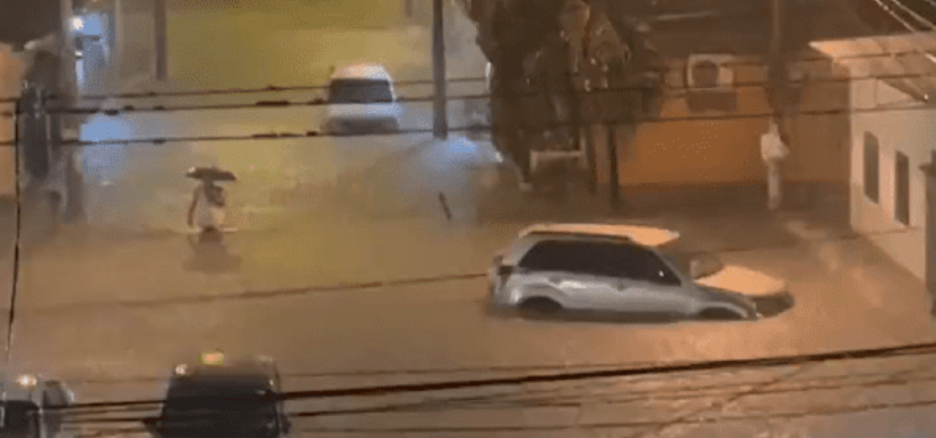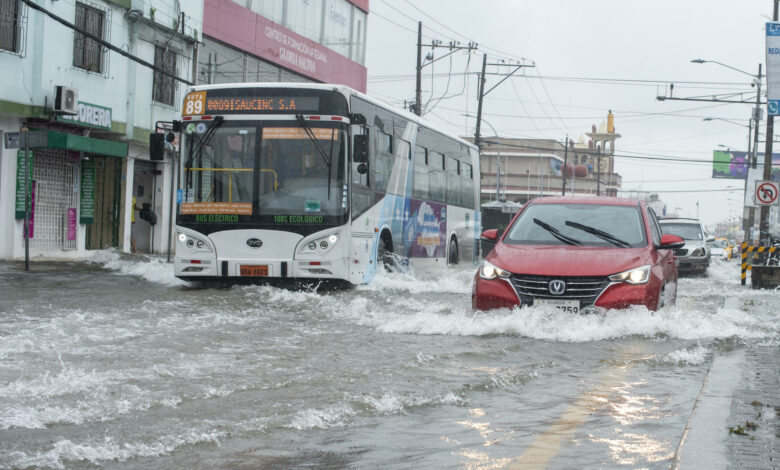
From March 22nd to March 23rd Latin America, especially Ecuador has experienced heavy rainfall and thunderstorm (JF, teleSUR). Most of Ecuador experienced heavy rainfall with the capital city of the province Guayas as well as some coastal reasons really being hit the most (JF, teleSUR). Within the city of Guayaquil major flooding has occurred (JF, teleSUR). The flooding and rain has caused the death of 21 individuals and is said to have affected 23,000 in a major capacity nationwide (Structural Collapses, Landslides, Flooding amid Heavy Rain in Guayaquil). This intense rain has caused the port-side industrial hub to be completely halted affecting the country of Ecuador greatly. In addition to this, the flooding has caused intense landslides that have completely wiped-out numerous forms of transportation as well as means for producing supplies for those struggling (JF, teleSUR). This isn’t just affecting Guayaquil but in reality, it is affecting the whole country. Due to the intense flooding, the country has had to delay most of its foreign trade shipments (JF, teleSUR). This could be a huge hit to the economy. The government currently is unsure of when Guayaquil and the surrounding areas of Guayas will recover.
The first article and author predominantly focused on the government and how they have been dealing with and recovering from this event alongside the general implications of the natural disaster. The article discussed the current president, Guillermo Lasso, who is currently receiving some criticism for his handling of this flooding (JF, teleSUR). In summary, he has tasked the governor of the city to coordinate in full to deliver any aid necessary to mitigate any damages (JF, teleSUR). This has received a major push back and to add to the flame the president left for the Ibero-American Summit on the 24th. He was not present and will not be present to give aid and support to those in his country who are struggling (JF, teleSUR). The conservative mayor of the capital, Mayor Cinthya Viter, has also been heavily criticized for their lack of presence and aid to the thousands of struggling citizens. The photo provided with this article shows cars halfway submerged on the streets with people trudging through water up to their chests (JF, teleSUR). The argument is very informational only really providing opinions through those that the reporter interviewed. There is anger towards the government that changes the focus of the article however it does a great job of providing clear and valid information. Based solely on the information that the author includes I assume he is against the president and most likely a liberal voter seeing that the president, as well as the mayor of Guayaquil, are conservatives.

The second article looks at the politics behind the situation much less and focuses more on the individuals affected. The first article didn’t discuss any fatalities or injuries whatsoever. Within this article, they provide clear statistics and numbers. The article states that roughly 21 individuals have been killed nationwide from this intense of flooding (Structural Collapses, Landslides, Flooding amid Heavy Rain in Guayaquil). Climate change is also referenced in this article using it as the main reason why this flooding and increased rainfall has occurred. The flooding could last up until Sunday and has the potential to worsen conditions even further. The municipality of Guayaquil has deployed upwards of 500 Transportation Agency workers, 250 firefighters as well as 300 water company workers to try and get on top of this situation (Structural Collapses, Landslides, Flooding amid Heavy Rain in Guayaquil). The author takes an extremely neutral stance in this article. There is almost no information provided that isn’t facts. Instead of discussing the government and political implications of the flooding, it discusses the number of people who died, the future plans as well as ongoing plans for relief (Structural Collapses, Landslides, Flooding amid Heavy Rain in Guayaquil).
These two stories practically have the same reason for being written, they both want to inform and debrief the current natural disaster occurring in Guayaquil. They both touch on the general disaster that occurred, the flooding, landslide, affected areas, etc. But where these two differ is when discussing the overall point of the arguments. The first article takes note of the public opinions on how the situation is being handled. This allows for political themes to arise changing the feel of the argument compared to the second article. The second article talks a lot more about statistics that are absent in the first article including but not limited to the death toll, current ongoing plans for immediate aid, as well as the long-term plans for getting the area back on its feet. It also talks more about the structural impacts of floods and landslides by including the conditions of important buildings like the airport and city hall. These differences are important simply because there is an audience for everything. If someone is looking for the politics behind this natural disaster, they should look at the first article. If say someone has a current family member in that area and is concerned and wants information on what is being done, they should look at the second article. The first article also seems to take a liberal stance whereas there is little to no political affiliation within the second article.

This story relates heavily to many of our class themes. When discussing Ecuador’s history, we see that it was predominantly under the direct jurisdiction of the Spanish crown (Ecuador – The Colonial Period | Britannica). Ecuador first became a colony of Spain in the year 1534 (Ecuador – The Colonial Period | Britannica). It wasn’t until the year 1820 that they won their freedom (Ecuador – The Colonial Period | Britannica). Colonization has a huge impact on countries because for hundreds of years they have been under the control of a different nation. This means they haven’t been able to provide for their country, expand or improve at all. They have spent years being subjects and once they finally achieved freedom they had to try and recover from the years of subjugation. It takes a great while to recover from this and most countries are still recovering which is why most developing nations are countries that won their independence from colonization in the 1800s. These countries are typically less advanced and most definitely less economically well off than other non-colonized nations. Ecuador is one of these nations which is why it has been such a struggle to provide aid for natural disasters such as this one. If you put it into perspective and compare it to flooding in the USA, it becomes very clear. We as a nation have the resources and economic stability to deal with a natural disaster quickly and effectively such as the one in Ecuador. The Ecuadorians do not have this, due largely in part to the setback they received from colonization. This is just one of the ways that these articles relate to class themes.
Sources:
“Ecuador – The Colonial Period | Britannica.” n.d. Accessed March 26, 2023.
JF, teleSUR/. n.d. “Ecuador: Heavy Rains Leave Guayaquil City Under Water.” Accessed March 26, 2023.